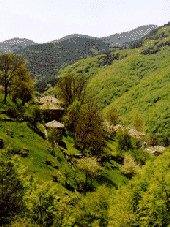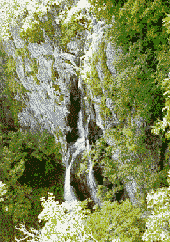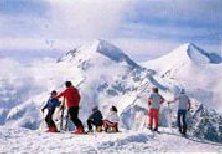|
|
| |
BULGARIA
MOUNTAIN RESORTS
BOROVETS
Borovets is the oldest and the biggest mountain resort in Bulgaria. It is located at 1350 above the sea level on the northern slopes of Rila mountain among age-old pine woods, at the foot of peak Mousala (2925 m) the highest one on the Balkan peninsula. Borovets is easily accessible, being at a distance of 73 km from Sofia (the capital of Bulgaria) and 126 km from Plovdiv. The nearest town is Samokov, which is 10 km far from the resort.
Borovets was developed into a modern ski resort of high class with luxury hotels, restaurants, discos, shops and of course an excellent network of ski runs and lifts along the slopes of the mountain. Borovets is a resort of Alpine type and provides excellent opportunities for a whole range of winter sports-Alpine sports, cross-country skiing, ski jumps and biathlon. The resorts has twice hosted World Cup Alpine skiing rounds. Its biathlon track is one of the best in the world.
The slopes of Borovets have a permanent snow cover from November to May, more than 1.5 m thick. The air in Borovets is crystal - clear and free of any pollutants. The average temperature during the coldest month January is - 4.6 ° C.
PAMPOROVO
Pamporovo is a modern ski resort in the heart of the Rodopa mountain, the mountain of the mythical singer Orpheus. It is the southernmost skiing resort in Europe.
 It is the sunniest Bulgarian winter resort with wonderful snow throughout the whole season. Pamporovo is situated on 1650 m above the sea level at the foot of peak Snejanka (1926 m). It is 260 km far from Sofia and 85 km from Plovdiv.
Pamporovo has an exclusive climate featuring a soft winter with about 120 sunny days during the skiing period. The significant influence of The Aegean Sea appears here and the skiing season starts from mid - December to mid - April. The average air temperature is - 3 ° C.
VITOSHA
The resort is situated very close to the capital of Bulgaria. It is situated on The Vitosha mountain, at 1800 m above the sea level, on the eastern slopes of Cherni Vrah (2290 m) which is the highest Vitosha's peak. This is Bulgaria's highest ski resort, only 22 km far from Sofia.
 Skiing conditions in Vitosha are excellent, with an extensive network of ski runs and lifts. Four new high-class hotels are situated in a compact group and offer comfort and entertainment to the tourists. The hotels are located near the natural ski slopes and runs and the lifts. There many small hotels and chalets in Vitosha too. Lots restaurants, bars, and night-clubs, a tavern, a ski bar and tea shops are also available. Ski rents are available near the runs.
BANSKO
The newest Bulgarian winter resort, recently discovered by the foreign tourists. Bansko provides an interesting combination between the virgin nature of Pirin Mountain and the atmosphere of the ancient Bulgarian small town.
Bansko ski resort is situated in Southwestern Bulgaria, at the foothills of one of the most beautiful Bulgarian mountains - Pirin, which is a national reserve, included in the WORLD NATURAL HERITAGE list. The distance from Sofia to Bansko is 160 km.
 The skiing conditions in Bansko are excellent. The Pirin mountain has a predonantly Alpine charachter with three peaks towering above 2900 m. However the slopes offer runs and tracks for all types of skiers, from novice to the experts, while the ski runs are maintained in excellent condition. The town itself attracts visitors by its 120 cultural monuments, its museums houses, and the permanent ethnographic and Bansko schlool of icon painting exhibitions.
|
|
|
Festivals and Fairs
The Great Koprivshtitza Folklore Festival
The Great Koprivshtitza Folklore Festival is Bulgaria's largest gathering of traditional musicians and singers and is a cross between a pop festival and a medieval fair. It is a sight that knows no equal: thousands of musicians and singers making the hillside above the picturesque village of Koprivshtitza their home for a few days. Coupled with this you have the colourful stalls of the traders and the thousands of visitors who come for the festival.
This is Bulgarian music as it was always played, played by the ancestors of those who first played it. But perhaps it is what happens on the periphery that is the most authentic. Strolling players or soloists, simply playing for the sheer enjoyment. forming new bonds with other musicians or just letting their music ring out over the hillside.
The Bourgas International Folk Festival
The Bourgas International Folk Festival, held annually, attracts a host of Bulgarian and international artists and is held in the second half of August.
The Kazanluk Festival
The Kazanluk Festival of the Roses is held annually in early June, and has grown from a local to an international event. Not only are the roses, Kazanluk's main industry, in full flower. but the town itself blossoms while visitors enjoy the "Rose Picnic" and all the fun of a folklore festival, with its costumes, songs and dance. Should you still have the energy left, you can always visit the old factories where the rose oil is extracted.
St. Trifon's Day
In the agricultural calendar, St. Trifon's Day celebrates the pruning of the vines, and is held on February 14.
Kukerov Den
On the first Sunday before Lent, Kukerov Den celebrates the start of the agricultural year, and all over Bulgaria you can witness processions led by the dancing. leaping Kukeri dressed in colourful masks and costumes.
Baba Marta
Baba Marta is celebrated on March 1 when peasant house-holds brush out the winter cobwebs with a traditional spring clean. and people offer each other tokens of good luck called martenitsas.
Kukeri
Like western countries. the Bulgarian calendar is dotted with important feast days and festivals. The festival of the Kukeri re-enacts ancient surovaki rites to ward off evil spirits and Kukeri fertility rites. Although only held once every five years, it brings together dancers from all over Bulgaria in a rainbow of colours and styles.
St. Lazarus Day
Lazaruvane is also celebrated in spring on St. Lazarus Day, and here village girls considered fit for marriage perform ritual songs and dances.
St. Konstantin and St. Elena Day
The coming of summer is traditionally celebrated on St. Konstantin and St. Elena Day on May 21, and in some of the remoter villages in the Stranzha hills fire dancing, dancing on heated coals, is still practised in celebration of summer's arrival. Ethnologists have suggested that this practice is directly descended from Dionysina rites of the ancient Thracian.
|